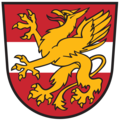Greifenburg | |
|---|---|
 | |
| Coordinates: 46°45′N13°11′E / 46.750°N 13.183°E | |
| Country | Austria |
| State | Carinthia |
| District | Spittal an der Drau |
| Government | |
| • Mayor | Josef Brandner (ÖVP) |
| Area | |
• Total | 76.28 km2 (29.45 sq mi) |
| Elevation | 644 m (2,113 ft) |
| Population (2018-01-01) [2] | |
• Total | 1,736 |
| • Density | 23/km2 (59/sq mi) |
| Time zone | UTC+1 (CET) |
| • Summer (DST) | UTC+2 (CEST) |
| Postal code | 9761 |
| Area code | 04712 |
| Website | www.greifenburg.com |
Greifenburg is a market town in the district of Spittal an der Drau in the Austrian state of Carinthia.


